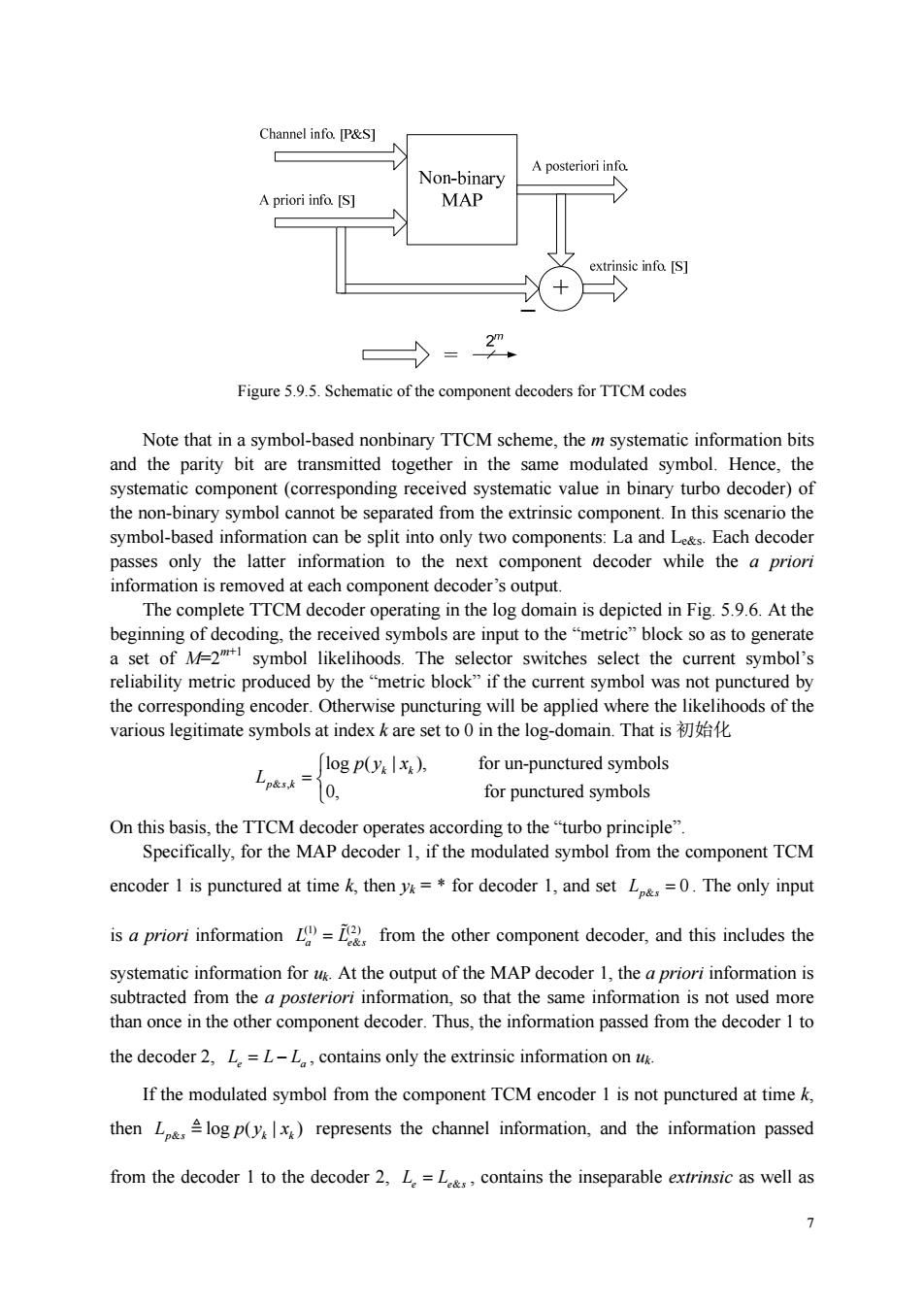正在加载图片...

Channel infa [P&S] A posteriori info Non-binary Apriori info [S] MAP extrinsic info [S] Figure 5.9.5.Schematie of the component decoders for TTCM codes Note that in a symbol-based nonbinary TTCM scheme,the msystematic information bits and the parity bit are transmitted together in the same modulated symbol.Hence,the systematic component(corresponding received systematic value in binary turbo decoder)of the non-binary symbol cannot be separated from the extrinsic component.In this scenario the symbol-based information can be split into ony Laand Each deode passes ony the latter information to the ne component decoder while the a priori information is removed at each component decoder's output. The complete TTCM decoder operating in the log domain is depicted in Fig.5.9.6.At the beginning of decoding,the received symbols are input to the"metric"block so as to generate a set of M-2 symbol likelihoods.The selector switches select the current symbol's eliability metric pr duced by the"metric block"if the current syr as not n ured b the corresponding enc oder Othe rwise puncturing will be applied where the pods of the various legitimate symbols at index k are set to 0 in the log-domain.That is flog p(ylx). for un-punctured symbols Lp= 0. for punctured symbols On this basis,the TTCM decoder operates acc ording to the"turbo principle Specifically,for the MAP decoder 1,if the modulated symbol from the component TCM encoder I is punctured at time k,theny+for decoder 1,and set =0.The only input is a priori information=from the other component decoder,and this includes the systematic information for .At the output of the MAP decoder 1,the a priori information is subtracted from the a posteriori information,so that the same information is not used more than once in the other component decoder.Thus,the information passed from the decoder I to the decoder 2,L=LL,contains only the extrinsic information on If the modulated symbol from the component TCM encoder 1 is not punctured at timek, (y)represents the channel information,and the information passed from the decoder I to the decoder 2.L=Lcontains the inseparable extrinsic as well as > 7 Figure 5.9.5. Schematic of the component decoders for TTCM codes Note that in a symbol-based nonbinary TTCM scheme, the m systematic information bits and the parity bit are transmitted together in the same modulated symbol. Hence, the systematic component (corresponding received systematic value in binary turbo decoder) of the non-binary symbol cannot be separated from the extrinsic component. In this scenario the symbol-based information can be split into only two components: La and Le&s. Each decoder passes only the latter information to the next component decoder while the a priori information is removed at each component decoder’s output. The complete TTCM decoder operating in the log domain is depicted in Fig. 5.9.6. At the beginning of decoding, the received symbols are input to the “metric” block so as to generate a set of M=2m+1 symbol likelihoods. The selector switches select the current symbol’s reliability metric produced by the “metric block” if the current symbol was not punctured by the corresponding encoder. Otherwise puncturing will be applied where the likelihoods of the various legitimate symbols at index k are set to 0 in the log-domain. That is 初始化 & , log ( | ), for un-punctured symbols 0, for punctured symbols k k p sk py x L ⎧ = ⎨ ⎩ On this basis, the TTCM decoder operates according to the “turbo principle”. Specifically, for the MAP decoder 1, if the modulated symbol from the component TCM encoder 1 is punctured at time k, then yk = * for decoder 1, and set & 0 L p s = . The only input is a priori information (1) (2) L L a es = & from the other component decoder, and this includes the systematic information for uk. At the output of the MAP decoder 1, the a priori information is subtracted from the a posteriori information, so that the same information is not used more than once in the other component decoder. Thus, the information passed from the decoder 1 to the decoder 2, L LL e a = − , contains only the extrinsic information on uk. If the modulated symbol from the component TCM encoder 1 is not punctured at time k, then & log ( | ) Lps k k py x represents the channel information, and the information passed from the decoder 1 to the decoder 2, L L e es = & , contains the inseparable extrinsic as well as